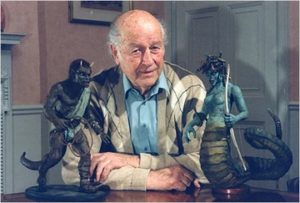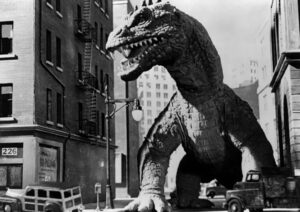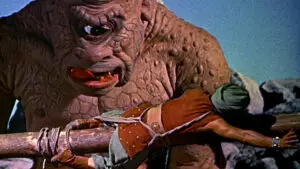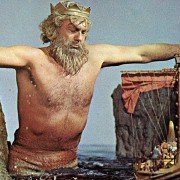The Story of Ray Harryhausen

Ray Harryhausen
“Without Ray Harryhausen, there would likely have been no Star Wars”
– George Lucas
We all know famous actors, actresses, and directors. They are revered like gods and often overly idealized. However, people forget that behind every film there are entire teams of people. Most of them remain anonymous. The Academy sometimes takes pity on them and awards them an honorary Oscar. In general, however, they often remain in the shadows. One such group is special effects specialists. They are responsible for some of the most memorable scenes in cinema history, yet on many film websites they are not even listed among the creators of a given work. The pioneer of practical special effects was undoubtedly Ray Harryhausen, who successfully brought ancient myths to life on the big screen.
Every self-respecting fan, especially of old cinema, must have come across this name at some point. This artist went down in history as a pioneer and master of so-called stop-motion animation using clay models. For many years, this technique was widely used as the primary means of bringing fantastic characters to life. It was mainly used in various fantasy, horror, and science fiction productions. Today, computers have taken over the role of creating special effects, and not only in the aforementioned genres. No one can imagine movies without CGI anymore, and its role in future productions will likely be even greater. However, it is sometimes worth turning to tradition and appreciating the work put into the development of cinema by artists such as Harryhausen.
Ray Harryhausen and his contribution to the development of fantasy cinema
And this influence was considerable. Harryhausen’s work was a cornerstone for the development of the fantasy genre in particular. His works became a model to follow and a point of reference for his contemporaries as well as for subsequent generations of artists. Suffice it to say that such renowned directors as Steven Spielberg, James Cameron, and Peter Jackson have admitted to being inspired by Ray’s work. Ray Harryhausen’s achievements were so groundbreaking and visionary that a separate term, “Dynamation,” was coined to describe them. The process involved superimposing separate layers of images, with a moving model in the center. This technique gave the effect a realistic appearance, allowing it to fully interact with its surroundings. The use of this solution became a benchmark for the entire industry. It was films using this technique that were watched with excitement in childhood by people who later became market leaders themselves.

The beast from 20000 Fathoms
Ray Harryhausen and the role of detail in animation
Harryhausen’s legacy can therefore still be seen on screens today, although the vast majority of viewers are probably unaware of this. The animator’s creations have a great power to capture the imagination. They can effectively inspire amateur filmmakers to dream up their own visions and encourage them to realize them. We owe Harryhausen some of the best early depictions of dragons and dinosaurs. His iconic monster from the depths, known as Rhedosaurus, is considered by many to be the direct inspiration for the 1954 film “Godzilla.” Echoes of his creations have resounded for decades in countless productions.
Anyone who has ever dabbled in any form of analog animation knows how painstaking this work is. It requires the creator to have, above all, angelic patience and extraordinary meticulousness. These were also the qualities that characterized Ray Harryhausen. What sets his work apart is mainly the incredible precision of the models and his attention to detail. These characteristics may initially escape the viewer, but a trained eye will notice the subtle touches that give the animations their natural feel. One example is the scene from “The Seventh Voyage of Sinbad” in which a cyclops roasts one of the sailors over a fire. While doing so, he licks his lips at one point. It lasts only a moment, but long enough to give the scene depth and expression. The dragon appearing in the same scene also makes a very expressive impression thanks to the visible movements of its body as it breathes.
The maneuvers of the characters created by Harryhausen were always characterized by a high degree of fluidity. Their movements were natural and perfectly synchronized with the action. It is clear that, with the benefit of hindsight and technological advances, these old films may be seen as outdated, but it should be remembered that for their time, they were truly innovative solutions. Every fan of cinema from years gone by probably feels a lasting fondness for these characteristically moving monsters, which played such an important role in the history of the entertainment industry.

The 7th Voyage of Sinbad
A brief history of Harryhausen’s works
Harryhausen began his career in the 1930s. His first inspiration was the work of stop-motion animation pioneer Willis H. O’Brien, known for “King Kong” (1933) and “The Lost World” (1925).
The two creators crossed paths during the production of the film “Mighty Joe Young,” in which Harryhausen made his debut as assistant chief animator. Ray’s first fully solo project was “The Beast from 20,000 Fathoms” in 1953. Three years later, the world saw “Earth vs. the Flying Saucers,” one of the greatest sci-fi classics of the 1950s. The film left a lasting mark not only on the genre but on pop culture as a whole. The scene in which one of the alien vehicles knocks down the Washington Monument is one of the most legendary in history. It also became a direct inspiration for Tim Burton’s 1996 comedy “Mars Attacks!”.
However, the real breakthrough came in 1958 with “The 7th Voyage of Sinbad”, Harryhausen’s first color film. In it, we can admire the artist’s most famous creations, including a cyclops, a naked woman, a dragon, a rook, and a skeleton. The design of the former in particular stood out from other similar characters and can easily be considered one of the best-made screen cyclopses. Figurines depicting this monster can still be purchased at online auctions for several hundred dollars. Another memorable sequence in the production is the sword fight between the main character and a reanimated skeleton. The actor had to learn all the moves by heart and then reenact this peculiar fight with a shadow in front of the camera. Harryhausen later used this experience in “Jason and the Argonauts” from 1963. There, however, he went a step further, as in the famous duel scene, the heroes fight against seven skeletons.
Another well-known project from this film is the giant Talos, a faithful copy of which appears in the game “Heroes of Might and Magic III.” However, Harryhausen did not specialize only in mythological creatures. He was equally adept at more naturalistic creatures. These included dinosaurs, among others. He created the largest number of them for the 1966 production “One Million Years B.C.”. He created eight prehistoric reptiles, whose models have survived to this day. The artist’s last significant work was Clash of the Titans from 1981. It is also probably the last significant film to use stop-motion animation. After all, it was the 1980s, and clay figures were already becoming a thing of the past.

Jason and Argonauts
The production does indeed look a bit archaic for that decade and is more reminiscent of works from the 1960s. However, it is still top-notch quality when it comes to traditional animation, and the creatures immortalized in it, such as Pegasus, Medusa, and the Kraken, have become permanently etched in the memory of fans. Harryhausen’s work continues to be appreciated and enjoyed by cinema lovers, and films featuring his models were often box office hits, with revenues several times higher than the initial budget. The animator’s creations are now just a reminder of a bygone era when artistic vision supported by manual talent and technique developed through many hours of practice was what mattered. At the same time, they remain an immortal tribute to creative genius, a tangible monument to the human imagination.
Sources:
E. Thom, “A tribute to Ray Harryhausen (1920–2013), a giant of animation,” National Science and Media Museum blog
M. Shanks, “Fictive realism – Ray Harryhausen’s model making”
